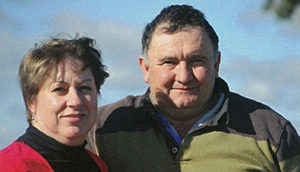Read the latest information on
Foot-and-mouth disease
 Richard and Jacquie Halliday from Bordertown, South Australia demonstrate that when it comes to managing ovine Johne’s disease (OJD), good communication is their biosecurity weapon of choice.
Richard and Jacquie Halliday from Bordertown, South Australia demonstrate that when it comes to managing ovine Johne’s disease (OJD), good communication is their biosecurity weapon of choice.
Thanks to their quick action and open communication with their neighbours and clients in managing their OJD experience, the Hallidays were chosen as one of three finalists in the 2013 Biosecurity Farmer of the Year Award.
The Halliday’s flock of 1750 Poll Merinos was diagnosed with OJD after a single positive test on a ewe was returned after 14 years of consistent negative test results through the Sheep National Market Assurance Program. A thorough investigation has now led the Hallidays to believe that the OJD infection was transferred via a shared watercourse.
The Hallidays immediately undertook a series of actions to help stem the spread of disease in their flock. Some of the biosecurity actions taken include the removal and slaughter of animals kept with the OJD-affected ewe, vaccination of the remaining flock and the introduction of new, vaccinated, stock.
Duncan Rowland, AHA Executive Director of Biosecurity Services, praised the transparent, honest and down-to-earth approach the Hallidays adopted in notifying their clients, suppliers and neighbours.
“Richard and Jacquie did not hesitate to act on their OJD discovery. As an example of their diligence, they contacted every one of their ram sale clients for the past two years and notified them of their OJD find”
“Regular updates on their OJD status were provided on their website and fellow neighbours and industry peers were also informed.”
“Up-front, crystal-clear communication is a key biosecurity tool and the Hallidays have used it very effectively,” Mr Rowland said.
The Halliday’s message to fellow producers is simple. ”Do not to take anything for granted and look outside the box when it comes to biosecurity. Everyone should take responsibility for their own properties to guard themselves against disease.”